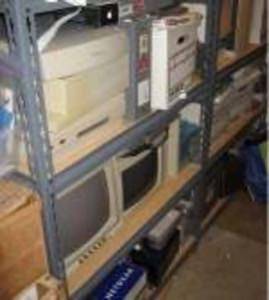Being able to access your files from anywhere and from any computer is one of the great conveniences of the always-on Internet. Online file storage has been around for quite a while, but the latest generation of services are so cheap and easy to use that there is almost no reason not to back some of your files up into the cloud. Most online storage providers also give you the ability to then share these files with your friends and colleagues. We selected the services on this list because they have a good track record of keeping your data safe while providing you easy access to your files from wherever you are.

Box.net
Box.net has been around for quite a while, but is still one of our favorite places to store documents online. Thanks to its integration with numerous online services, including Gmail, Zoho, picnick, and Scribd, box.net can not only store all your documents, but can also function as the hub of your virtual office.

One other nice feature of box.net is that you can share your files and folders with ‘collaborators,’ which makes it a good service to exchange files within a small business or among friends.
The storage limit for the free accounts is 1GB, which is plenty if you mostly exchange text documents or spreadsheets. Paid accounts start at $7.95 a month and include more advanced features, including 5GB of storage, a versioning system, mobile access, and 24/7 phone support.
Live Mesh
The online storage component of Live Mesh is only one part of Micorsoft’s latest venture into cloud computing, but it is also one of its most compelling features at this point. Live Mesh gives you 5GB of online storage and an online desktop that looks a lot like Windows Vista. You can upload any type of file to Live Mesh, but you cannot edit any of your files through the online desktop. In the future, though, we expect Microsoft to start adding more of these features.

One of the main reasons we like Mesh is because it constantly watches for changes in the folders you are synchronizing to it and updates them automatically. In addition, you can share folders with friends, allowing you to collaborate on projects.
Live Mesh works on both Windows PCs and Macs.
DropBox
Few online storage services integrate with your desktop as well as DropBox, which only recently opened up to the public after an extensive beta test. While you do have to install a small program on your machine to run DropBox, it is well worth it. Besides setting up a folder on your machine, which automatically syncs with DropBox, you can also set DropBox up to then sync that folder with other machines, similar to Live Mesh. DropBox lets you upload any type of file, as long as it is smaller than 350MB. DropBox uses Amazon’s S3 service as its storage solution and provides its users with 2GB of free storage. For $9.99 a month or $99.99 a year, you can buy 50GB of storage.

One of our favorite features of DropBox is that it preserves every revision of every file. You can also easily share folders with your friends or colleagues.
DropBox supports Windows XP and Vista, Mac OSX, and Linux.
Oosah
Oosah‘s main selling point is simple: you get a whopping 1 terabyte of storage for media files. One restriction of Oosah is that you can’t use it for text documents, spreadsheets, or presentations, which seems a bit weird, given that those types of files are generally small.

One interesting aspect of Oosah is that it accepts RAW image files from most camera manufacturers, though it automatically converts them into JPGs. You can also connect to your Picasa, Flickr, Facebook, and YouTube accounts and view your images and videos from those services in one central place. Oosah also gives you Media RSS feeds and even a podcast feed for your audio files.
While we love Oosah for its general ease of use, the one aspect we really did not enjoy was the fact that uploading files seems to be unnecessarily hard. Oosah does not provide any desktop clients and while you can use the web based uploader to select multiple files, uploading multiple directories at a time is not an option.
JungleDisk
JungleDisk is the only service in this list that is not available for free – and technically, it is not even an online storage service. Instead, it provides a frontend to Amazon’s S3 storage service. JungleDisk costs $20 and after that, you pay Amazon for the storage and transfer of your files. JungleDisk also lets you map your Amazon S3 storage space as a network drive on your computer, so that you can just drag and drop files back and forth between your online storage and your local desktop.

JungleDisk is available for Windows, Mac OSX, and Linux.
Other Services
Online storage is a competitive market. The best services integrate fully with your desktop and allow you to effortlessly upload and download files. They also provide you with an online desktop to access files from any computers and are stable and dependable. A service that does not fulfill these basic requirements is going to have a hard time convincing users to use and trust it.
There are, of course, a large number of other online storage services that we did not include in this list. BOXSTr, for example, is a great application, but it constantly bothers you with ads and attempts to sell you their premium service. AOL’s Xdrive is a great service, too, but we have heard too many rumors that AOL is trying to sell the service or that they will simply close it to be able to recommend it anymore.
The one company that is suspiciously missing from this list is Google. While you can upload your documents to Google Docs, the company that has made cloud computing a household name does not have a dedicated file storage service. While rumors about the existence of a ‘GDrive’ have regularly appeared in the tech blogosphere over the last few year, users still have to rely on hacks like the GMail Drive shell extension to store their files on Google’s servers.
What Did We Miss?
Do you have a favorite service that we did not list? Let us know in the comments.
Logo courtesy of Flickr user blakespot.





















